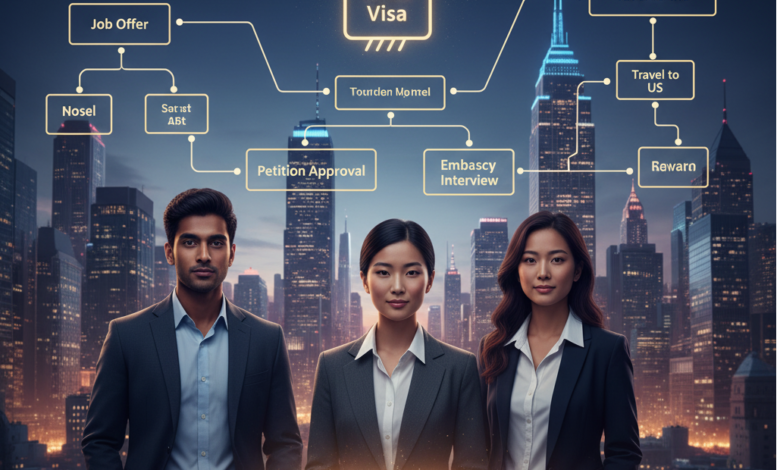What is the H-1B Visa? A Complete Beginner’s Guide

Understanding the H-1B Visa
The H-1B visa is a non-immigrant classification that allows U.S. employers to temporarily employ foreign workers in specialty occupations. The significance of the H-1B visa lies in its role as a crucial tool for U.S. businesses seeking to fill gaps in their workforce with highly skilled talent from around the world. This visa is particularly valuable in fields that demand a high level of specialized knowledge, including information technology (IT), engineering, healthcare, and financial services.
To qualify for the H-1B visa, applicants must meet specific eligibility criteria. First and foremost, the foreign worker must possess a minimum of a bachelor’s degree or its equivalent in a relevant field. This requirement ensures that individuals entering the U.S. on an H-1B visa bring the necessary educational background to meet the demands of their positions. Additionally, the job offered by the employer must be consistent with the specialty occupation designation, indicating that the role requires specialized skills that align with the worker’s expertise.
The H-1B visa not only benefits U.S. employers but also promotes global talent mobility. By allowing companies to recruit individuals with rare skills, the H-1B visa fosters innovation and helps organizations remain competitive in an increasingly globalized economy. Furthermore, the contributions of H-1B visa holders have a significant impact on the U.S. economy, often resulting in enhanced productivity, job creation, and technological advancements. This dual benefit reinforces the importance of the H-1B visa as a bridge linking international expertise with U.S. industry needs, showcasing its essential role in both economic growth and workforce development.
Eligibility Requirements and Application Process
The H-1B visa program is designed for foreign nationals seeking employment in the United States in specialty occupations. To qualify for this visa, applicants must meet certain eligibility requirements, primarily revolving around the necessity of a job offer from a U.S. employer. An essential criterion is that the position must be classified as a specialty occupation, typically requiring a bachelor’s degree or higher in a specific field. Professions that commonly qualify include those in areas such as information technology, engineering, mathematics, and accountancy.
Potential applicants are also evaluated based on their educational and professional qualifications. A bachelor’s degree or its equivalent in the relevant field is generally mandatory. In some cases, relevant work experience may substitute for the formal educational prerequisites, whereby three years of professional experience correlates to one year of higher education. Consequently, candidates should be prepared to provide thorough documentation of their qualifications as part of the application process.
The application process for securing an H-1B visa involves several key steps that prospective applicants must follow meticulously. Initially, employers must file a Labor Condition Application (LCA) with the U.S. Department of Labor, ensuring compliance with wage and working conditions. After obtaining LCA approval, the employer proceeds to file Form I-129, the Petition for a Nonimmigrant Worker, with the U.S. Citizenship and Immigration Services (USCIS). It is at this stage that the USCIS evaluates the petition based on the provided credentials and employment conditions.
Further, it is imperative for applicants to be aware of the timelines and deadlines associated with the H-1B application process. The filing period typically begins on April 1 each year, with a limited cap on the number of visas allocated. Detailed attention to these deadlines is crucial to enhance the likelihood of successful application approval.
H-1B Visa Quotas and Cap-Exempt Employers
The H-1B visa program is subject to an annual cap, which plays a crucial role in regulating the number of visas granted each fiscal year. Typically, the U.S. government issues 65,000 H-1B visas annually for prospective employees in specialty occupations. Additionally, there is a further allocation of 20,000 visas specifically reserved for foreign nationals who hold a master’s degree or higher from a U.S. institution, making it vital for them to understand the lottery system that dictates the allocation of these visas.
Each year, a significant demand for H-1B visas often results in surpassing this cap. If applications exceed the cap, U.S. Citizenship and Immigration Services (USCIS) employs a randomized lottery system to select the applications that will be processed. This system creates uncertainty for job seekers and employers alike, as only a fraction of applicants are ultimately granted visas. As a result, this competitive environment necessitates that candidates explore various strategies to enhance their chances of securing an H-1B visa.
Notably, some employers qualify as cap-exempt, meaning they can sponsor H-1B visas without being restricted by the annual cap. Cap-exempt employers generally include higher education institutions, nonprofit research organizations, and government research organizations. This exemption allows them to hire international talent without the constraints imposed by the visa limits, thereby expanding opportunities for both employees and institutions engaged in research and academic endeavors.
The implications of the H-1B cap are significant for job seekers. Those who narrowly miss out in the lottery may need to consider alternatives, such as applying for other visa categories, including the O-1 visa for individuals with extraordinary abilities or the L-1 visa for intracompany transferees. Understanding the intricacies of the H-1B visa cap can empower applicants to make informed decisions in their pursuit of employment in the United States.
Maintaining H-1B Status and Pathways to Permanent Residency
Maintaining H-1B status is crucial for visa holders to remain legally employed in the United States. H-1B visa holders must comply with specific regulations, which require them to maintain ongoing employment with the sponsoring employer who filed the H-1B petition. Any change in employment, such as a job loss or a switch to a different employer, necessitates a new petition submitted to the U.S. Citizenship and Immigration Services (USCIS). Failure to maintain valid H-1B status can lead to unauthorized stay and possible removal from the U.S.
Visa holders are entitled to extend their H-1B status for a maximum of six years, typically divided into three-year increments. However, those in the process of applying for permanent residency may qualify for additional extensions beyond the standard six-year timeframe. Employers must file for the extension well before the current expiration date, making timely applications critical. The extension process requires the submission of the Form I-129, along with compelling evidence demonstrating the ongoing need for the employee’s specialized skills.
The transition from H-1B status to permanent residency often involves applying for a Green Card. Visa holders typically pursue this route through employment-based categories, which can include EB-1 for extraordinary ability individuals, EB-2 for professionals with advanced degrees, or EB-3 for skilled workers. Each category has its unique requirements, including labor certification processes and the potential need for employer sponsorship. Additionally, some H-1B holders may also consider family-based options for permanent residency.
Visa holders must be well-informed about their responsibilities while in H-1B status and proactively prepare for their transition to permanent residency. This strategic planning can enhance their opportunities for a successful future in the United States.






















